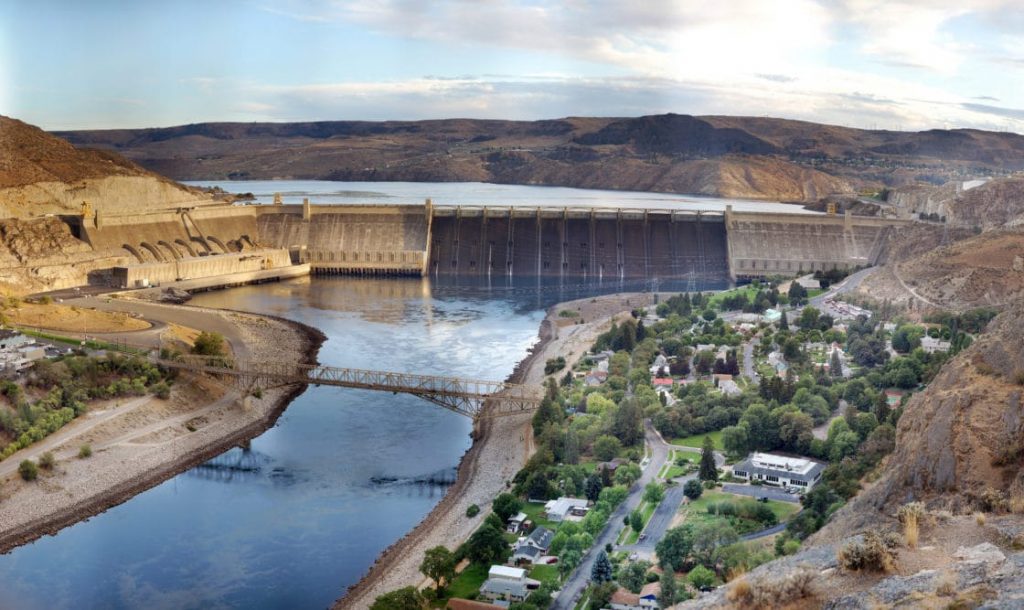
1. Grand Coulee Dam
The Grand Coulee Dam, a concrete gravity dam, is located on the Columbia River west of Spokane, Washington and is listed by the American Society of Civil Engineers as one of the seven civil engineering wonders of the United States. The dam’s reservoir, Franklin D. Roosevelt Lake, stretches 150 miles north and almost reaches the Canadian border. The dam was constructed to provide hydroelectric power and irrigation.
Even more enormous than the Great Pyramid of Giza, the Grand Coulee is an absolutely massive structure, and one of the largest ever constructed by mankind. The 550 foot tall dam contains over 12 million cubic yards of concrete, which is enough to build a highway all the way from Miami, Florida to Seattle, Washington, and stretches 5,223 feet — just 57 feet shy of a mile. The construction of the Grand Coulee dam took place between 1933 and 1942 and provided jobs to thousands of men during the Great Depression. The Grand Coulee provided the immense electrical power needed to manufacture aluminum for the production of World War II planes and ships, and, continuing in its war-like vein, it also powered the production of plutonium at a secret lab on nearby Hanford Site. Plutonium, of course, turned out to be the key ingredient of the atomic bomb – and the rest is history.
The dam is not without some controversy. 77 men lost their lives during the construction of the dam and its original two powerhouses, and another four perished during the construction of the third power plant constructed between 1967-1975, bringing the final death count to 81. Also, creation of the reservoir partially flooded the ancestral lands of Native Americans and forced the relocation of over 3,000 people, and environmentalists have condemned the dam for blocking the migration of salmon and steelhead to spawn.
Today, the Grand Coulee is used to irrigate about 670,000 acres of farmland used for growing grains, fruits, vegetables, and wine grapes, as well as livestock grazing.
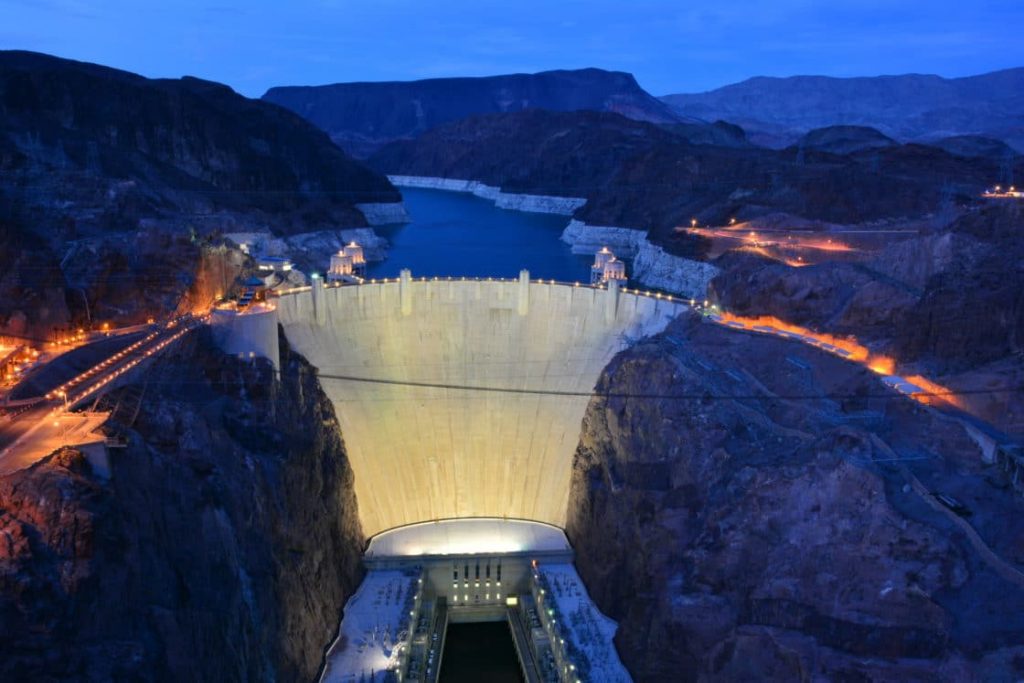
2. Hoover Dam
The Hoover Dam, located in the Black Canyon of the Colorado River on the border of Arizona and Nevada, is a massive concrete arch-gravity dam whose 600-foot base is as wide as the full length of two football fields. The giant concrete wedge stands 726 feet tall, or the height of a 60-story building, and holds back the immense power of the Colorado River. The Hoover Dam was constructed in order to generate electricity as well as provide irrigation and control flooding, and today generates about four billion kilowatts of electricity per year – enough to provide the power needs for 1.3 million people.
At the time of its construction between 1931 and 1935, the Hoover Dam was the most expensive engineering project in United States history at a cost of $49 million, which, adjusting for inflation, would be $700 million by today’s standards. The Hoover Dam created the enormous reservoir known as Lake Mead, which even today is the largest manmade reservoir in the U.S. at 110 miles long and 560 feet deep. In addition, the Hoover Dam and beautiful Lake Mead have created a bustling tourism community by providing plenty of outdoor recreation including boating, swimming, and fishing. Lake Mead also supplies municipal water for Las Vegas, Phoenix, and Tucson, and provides storage during drought.
Building the Hoover Dam took enormous effort. Construction of the dam utilized 91.8 billion cubic feet of concrete to create a retaining wall that weighs about 6.6 million tons. In fact, the mass of concrete in the Hoover Dam would pave a road from San Francisco to New York City. In addition, the volume of water in Lake Mead, when filled to capacity, is enough to submerge the entire state of Connecticut in ten feet of water. Incredibly enough, although the dam was expected to take five years to construct, it was actually completed ahead of schedule. 96 people died during the construction of the Hoover Dam; however, contrary to the popular urban legend, none of the deceased are encased within the dam’s concrete.
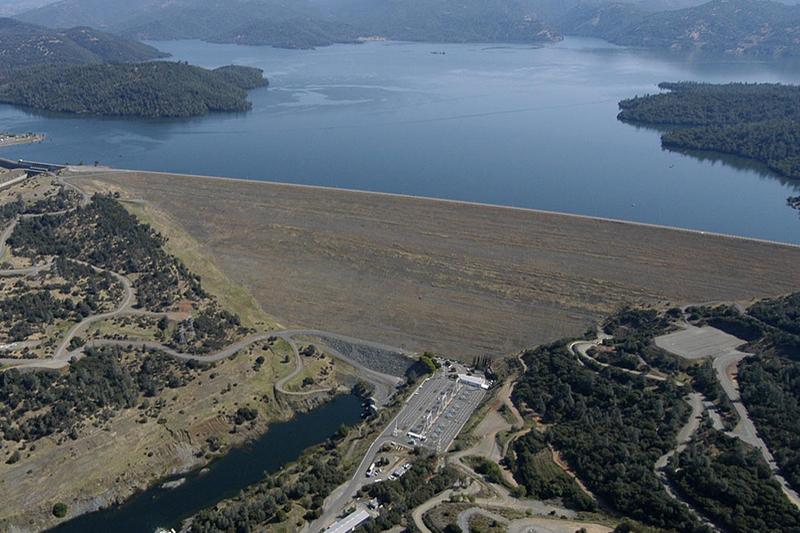
3. Oroville Dam
Oroville Dam, located about 70 miles north of Sacramento at the three forks of the Feather River, is the tallest dam in the United States, standing over 770 feet tall. The dam is an earthfill dam that holds back Lake Oroville, a manmade reservoir containing 3.5 million acre-feet of water. Oroville Dam stretches three quarters of a mile at its base and almost 7,000 feet across at its top.
The most highly monitored dam in the world during construction, the Oroville Dam was built between 1961 and 1967, and was officially dedicated in 1968. Just seven short years later, in 1975, a significant earthquake struck a few miles southeast of Oroville, and the new dam was put to the test. To the credit of the engineers, the dam oscillated with the earthquake and did not suffer a solitary crack or leak.
The Oroville Dam, along with its reservoir, Lake Oroville, not only provides drinking water, water storage, and hydroelectric power, it also protects downstream residents from the flooding of the Feather River. Providing about 750,000 acre-feet of flood control storage, the Oroville Dam has minimized damage from floods that have occurred in every decade since the dam’s construction. It also provides a beautiful location for a plethora of recreational activities including boating, camping, and fishing.
Tragically, 34 men died during the construction of the Oroville Dam. Just two years after the dam’s completion, President Richard Nixon signed the Occupational Safety and Health Act (OSHA) into law, drastically reducing the number of workplace accidents and casualties.
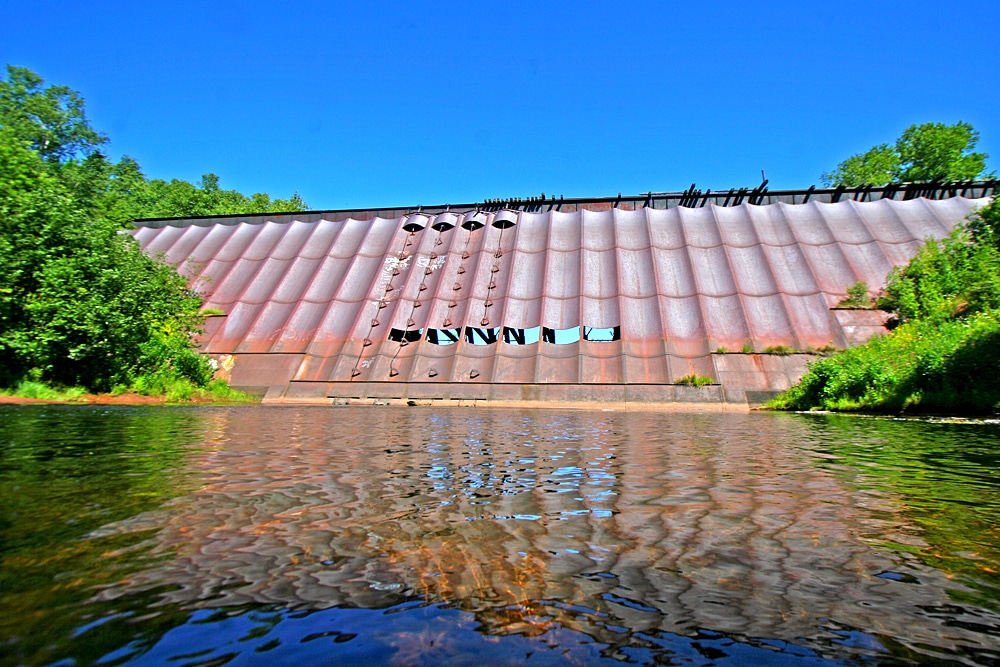
4. Redridge Steel Dam
Located across the Salmon Trout River in Redridge, Michigan, the Redridge Steel Dam is is a flat slab buttress dam constructed of steel. Steel is rarely used for construction of dams, which are typically earthenworks or masonry, and the Redridge Steel Dam is one of only three steel dams ever constructed in the United States. The other two are the Ashfork-Bainbridge Steel Dam, constructed in Arizona in 1898 to supply water for railway operations and still fully operational, and the Hauser Lake Dam, which was constructed in 1901 in Montana but failed less than a year later.
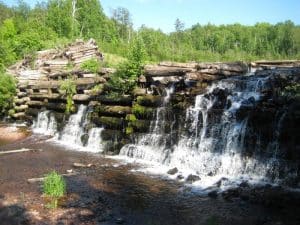
Prior to the construction of the Redridge Steel Dam, the Atlantic Mining Company built a timber crib dam across the Salmon Trout River in order to create a reservoir to supply water for mining operations. The reservoir created by the timber crib dam was insufficient, and so the Redridge Steel Dam was built; however, the original timber crib dam remained submerged in place upstream of the new dam. After operating for several decades, the Redridge Steel Dam fell into disrepair after mining operations ceased, and in 1941, the dam broke and caused a flood. The dam owners opened the spillways and cut holes in the steel dam so that it would no longer retain any water, and in this way the original timber dam was revealed — and along with it, breathtaking waterfalls.
With the threat of being labeled a “significant hazard” dam by the Michigan Department of Environmental looming, the timber dam was lowered 13 feet in 2004 in order to relieve pressure and make it safer. While a more permanent solution is still needed, both dams have been estimated to be safe for the foreseeable future, allowing visitors the ability to appreciate the lovely falls created by the old timber dam.
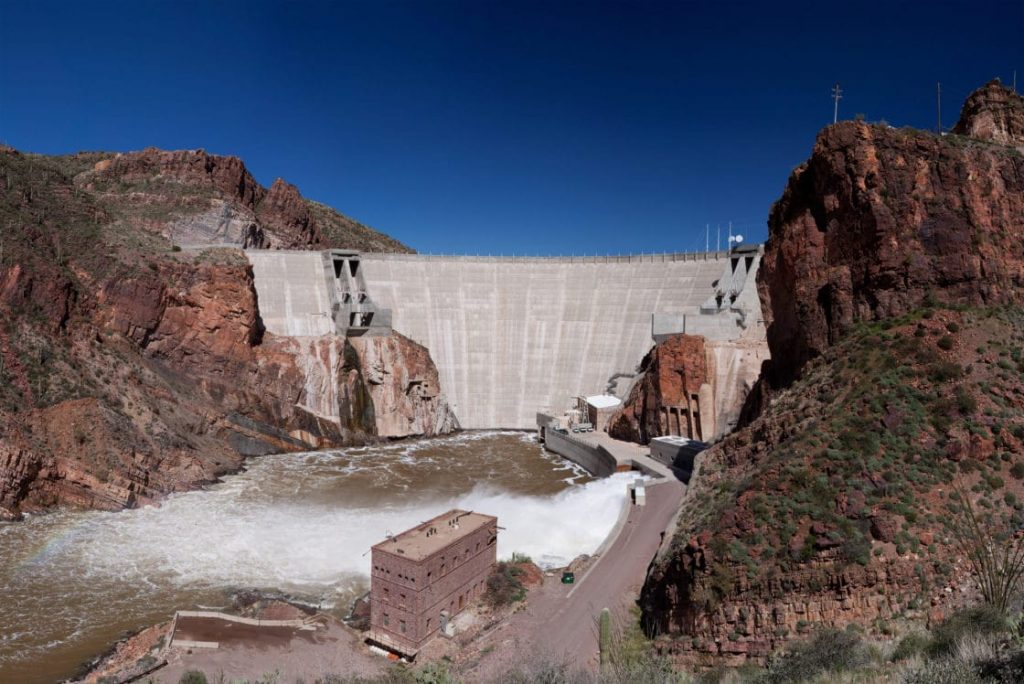
5. Roosevelt Dam
Constructed between the walls of a box canyon near the Salt River and Tonto Creek, the Roosevelt Dam was the first water project built under the 1902 Reclamation Act, and was the largest masonry dam in the world at that time. Italian stonecutters carved the stones used in the construction of the dam from the nearby cliffs, and when completed, the dam stood 280 feet tall and 184 feet wide at its base. The dam supplied water and electricity while also controlling the dangerous floods that had plagued the nearby Phoenix area.
Construction of the dam occurred between 1905 and 1911 while Arizona was still just a territory, and the total cost was $10 million. Supplying electricity to rural households, the Roosevelt Dam was a modern marvel. It would be ten years before the National Rural Electrification Act brought power to the rest of rural America, and so Phoenix quickly became a bright, modern city, and Arizona officially became a state only one year after the dam’s completion. The Roosevelt Dam was listed as a National Historic Landmark in 1963 and, to this day, it adorns the state seal of Arizona.
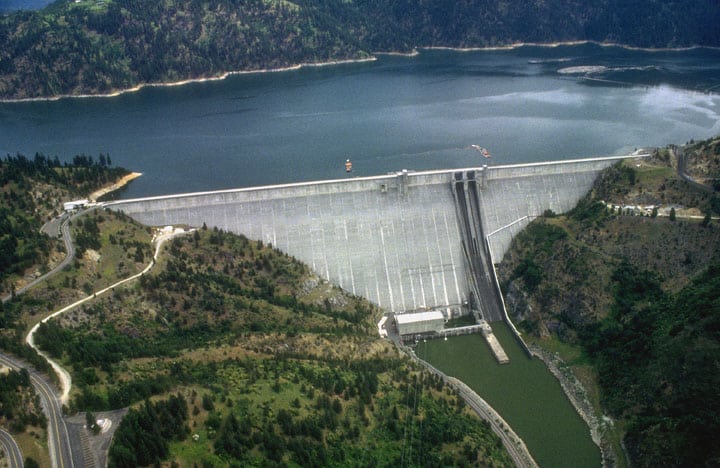
6. Dworshak Dam
Located just outside the city of Orofino, Idaho on the North Fork of the Clearwater River, the Dworshak Dam is the tallest straight axis gravity dam in the Western Hemisphere and the third highest dam in the United States. Constructed between 1966 and 1973, the Dworshak Dam is primarily used for flood control and hydroelectric power. The dam has three power-generating unts and received authorization for three more in 1990; however, the authorizations were revoked amid political controversy and citizen opposition when it was found that a second dam would be needed to handle peak loads.
The reservoir created by the Dworshak Dam holds almost 3.5 million acre-feet of water and is 53 miles long. The dam stands 717 feet tall, generates 380,000 kilowatts of power, and contains more than twice the concrete than does Cheope’s Great Pyramid in El Giza, Egypt.
Perhaps more notable than its significant mass is the controversy that has surrounded the Dworshak Dam since its inception. In his travel guide Idaho for the Curious, Cort Conley writes, “There have always been more politicians than suitable damsites. Building the highest straight axis gravity dam in the Western Hemisphere, on a river with a mean flow of 5,000 cubic feet per second, at a cost of $312 million, in the name of flood-control, is the second-funniest joke in Idaho. The funniest joke is inside the visitor center: a government sign entreats, ‘…help protect this delicate environment for future generations.’ The North Fork of the Clearwater was an exceptional river with a preeminent run of steelhead trout, and the drainage contained thousands of elk and white-tail deer. The Army Corps of Engineers proceeded to destroy the river, habitat, and fish; then acquired 5,000 acres for elk management and spent $21 million to build the largest steelhead hatchery in the world, maintaining at a cost of $1 million dollars a year what nature had provided for nothing.”
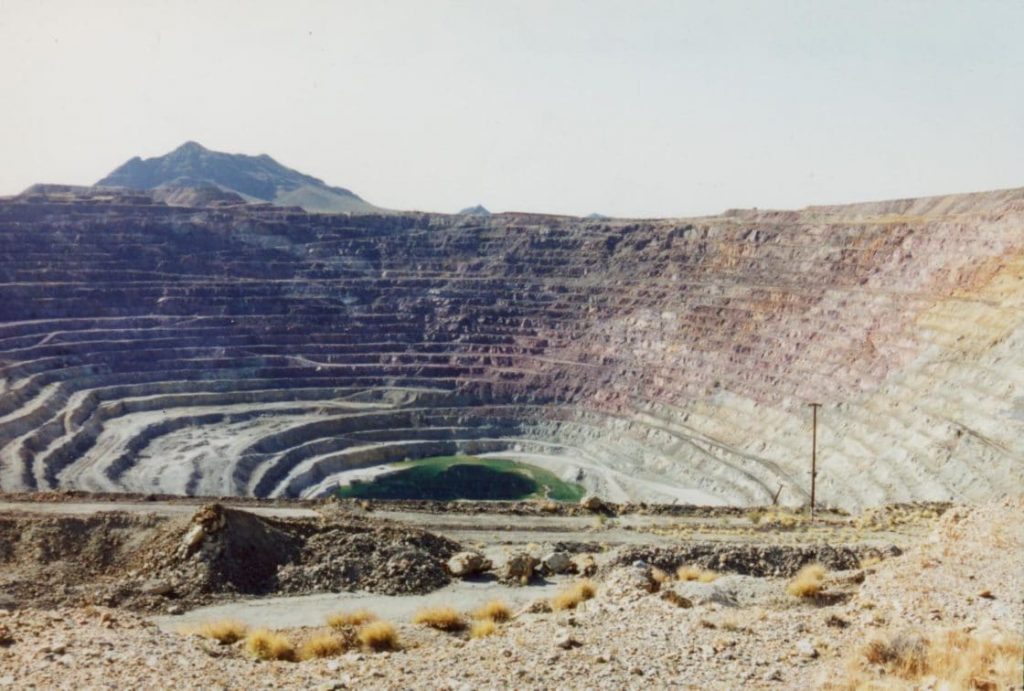
7. New Cornelia Mine Tailings
OK, so the New Cornelia Mine Tailings is not really a dam per se, but it IS often cited as the largest dam structure in the country by its volume of 7.4 billion cubic feet. Located just south of Ajo, Arizona, the New Cornelia Mine was operational from 1912 until 1983, when it closed due to the low price of copper. Mine tailings are waste materials such as bits of rock, dirt, mud, and process effluent from the mining process. While the mine was operational, the tailings were heaped into an enormous pile in order to hold back future tailings, and therefore the tailings pile is actually considered a dam. Today, Phelps Dodge owns the mine. There has also been recent talk of mining the tailings, although nothing has yet been scheduled.
Do you agree with our list of the 7 most interesting dams in the United States or do you know of a dam that should be included? Let us know – we’d love to hear from you!
